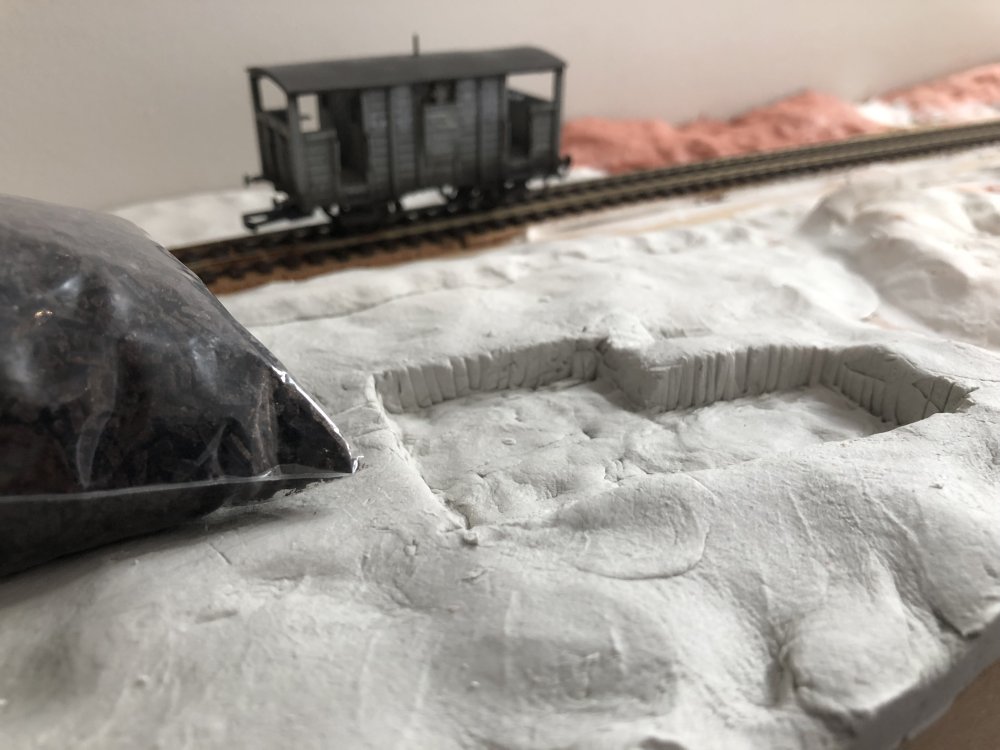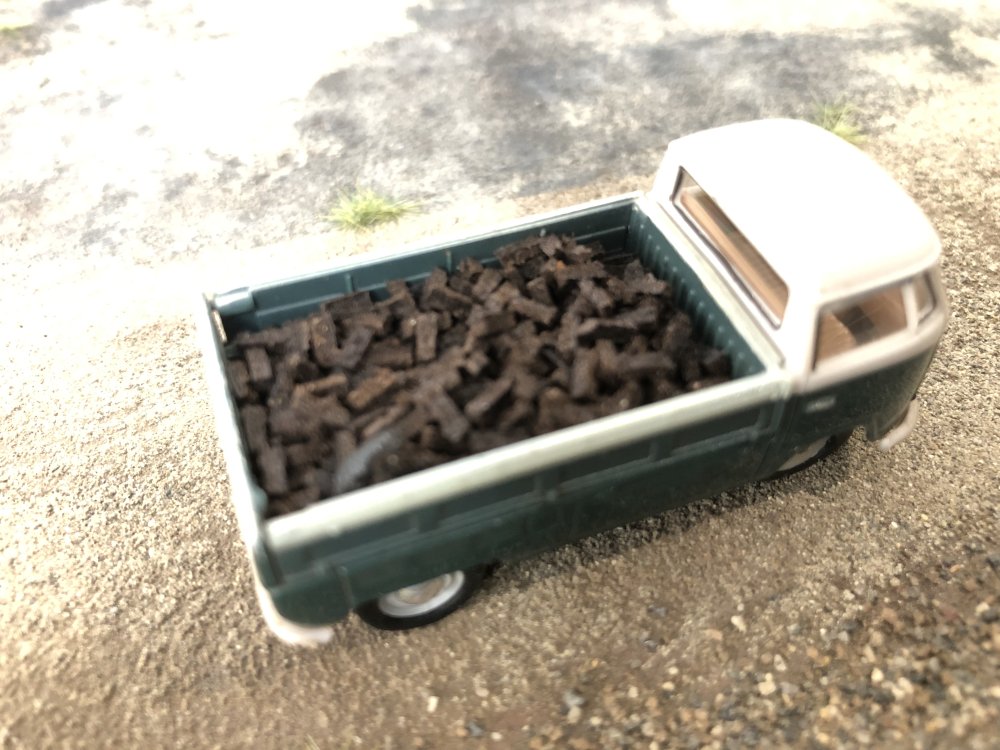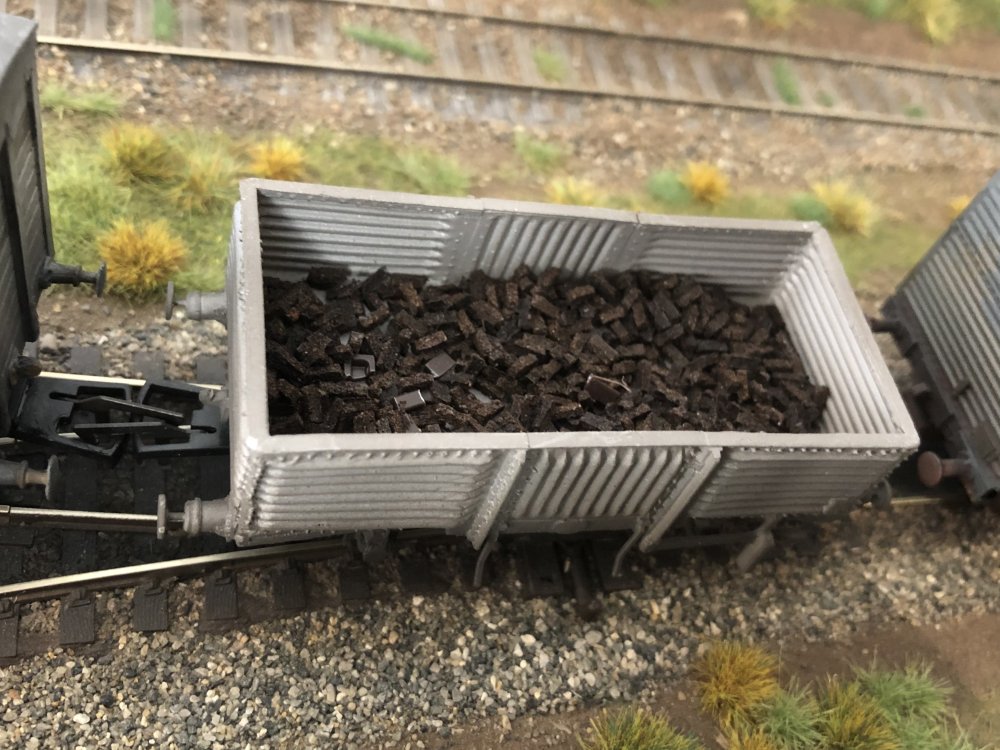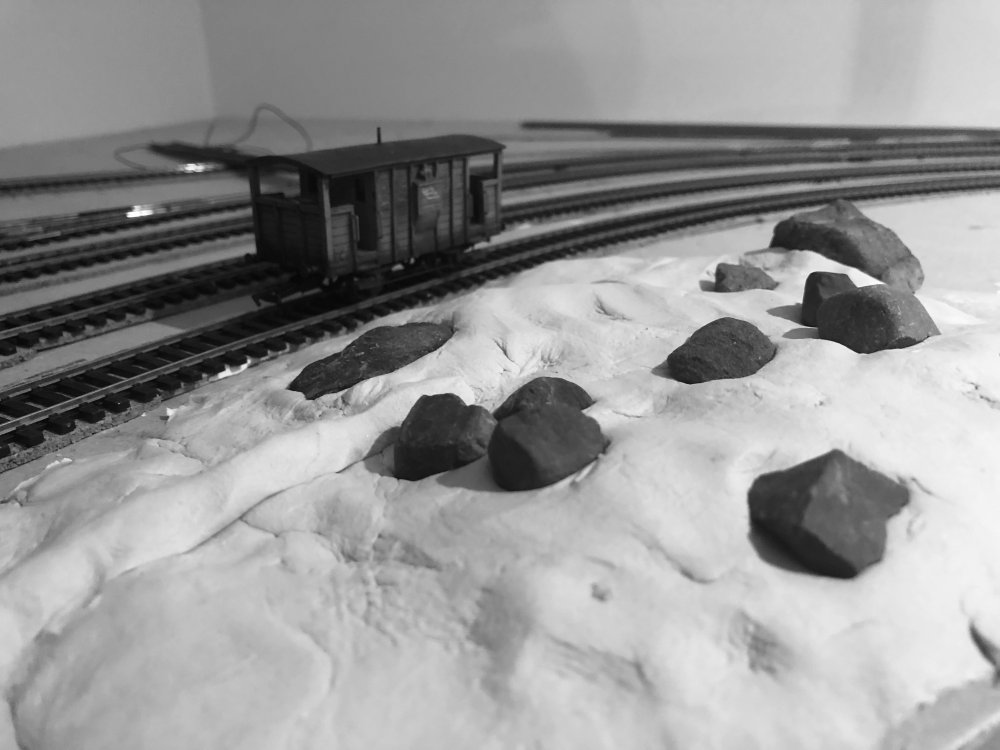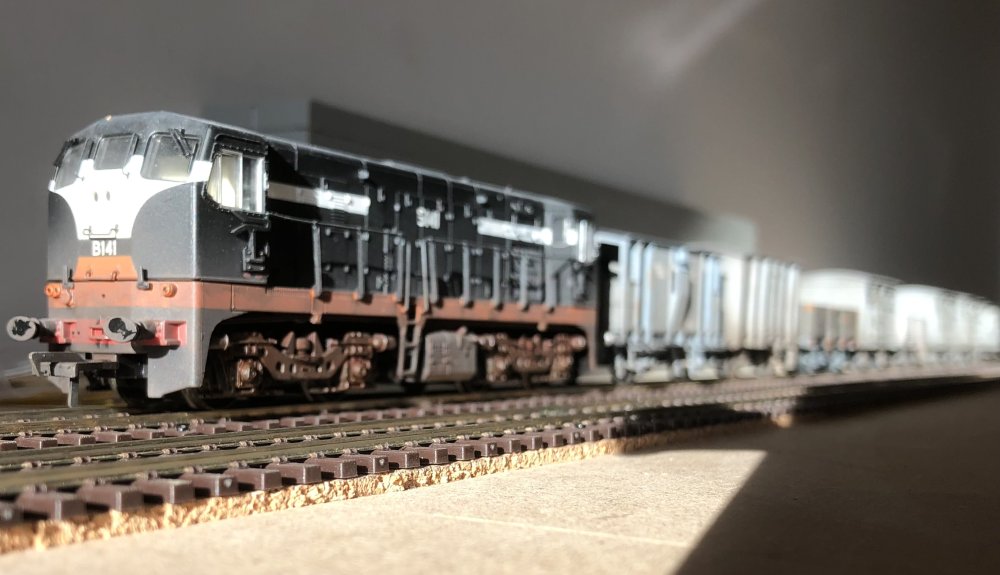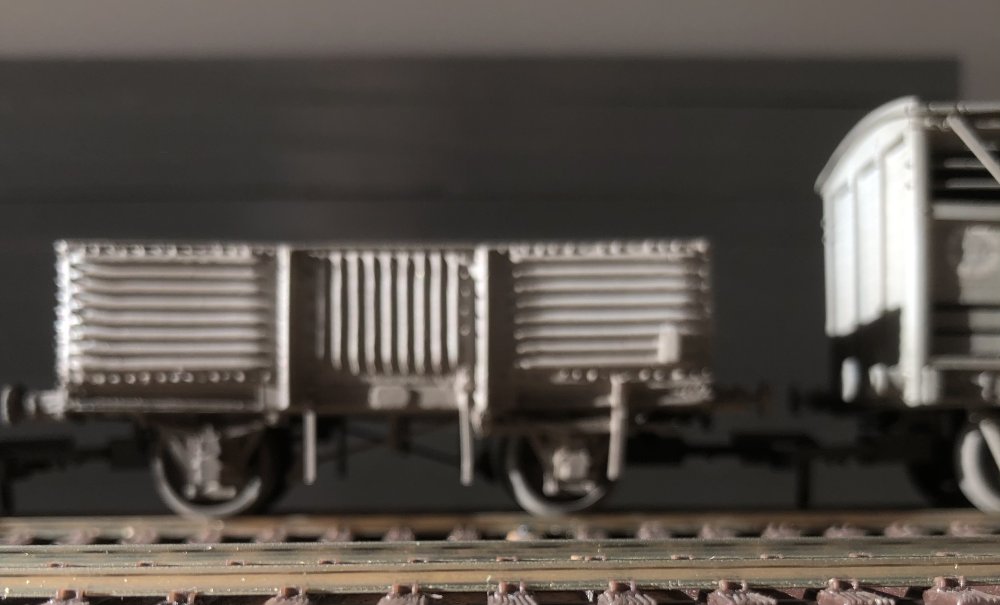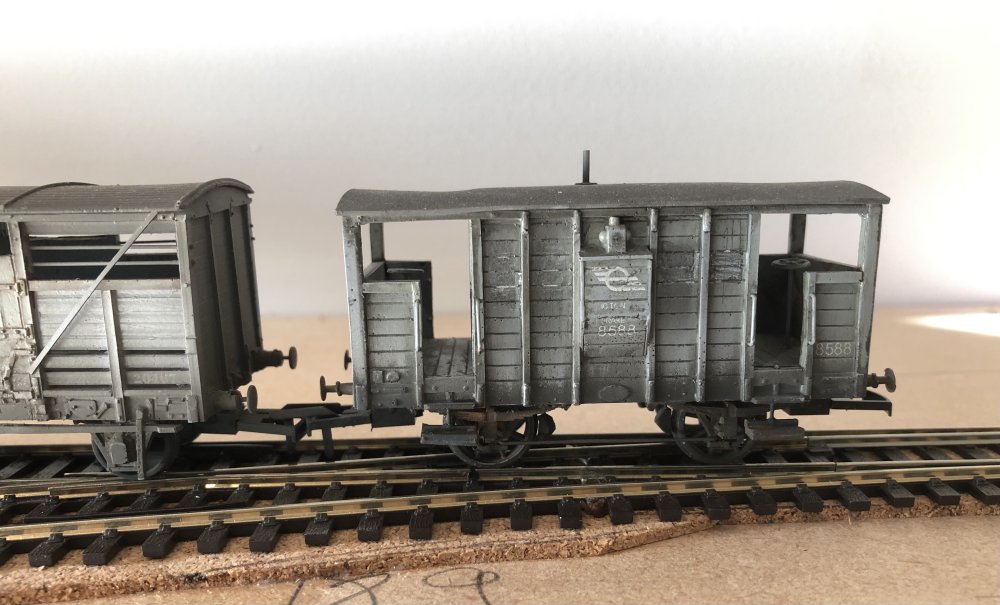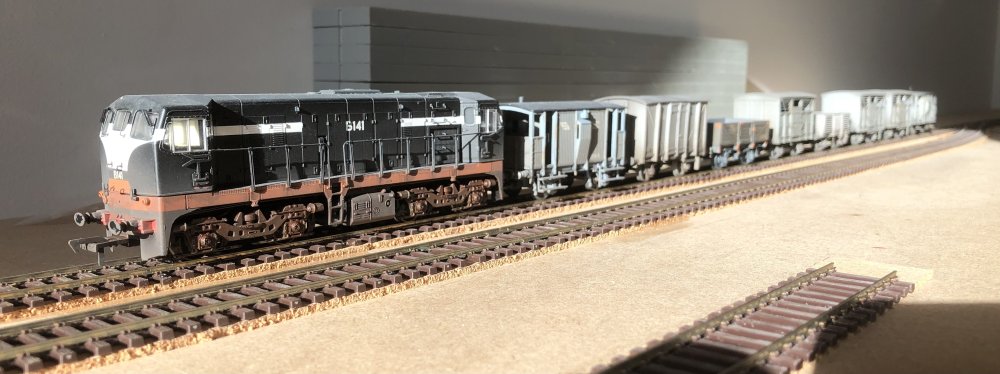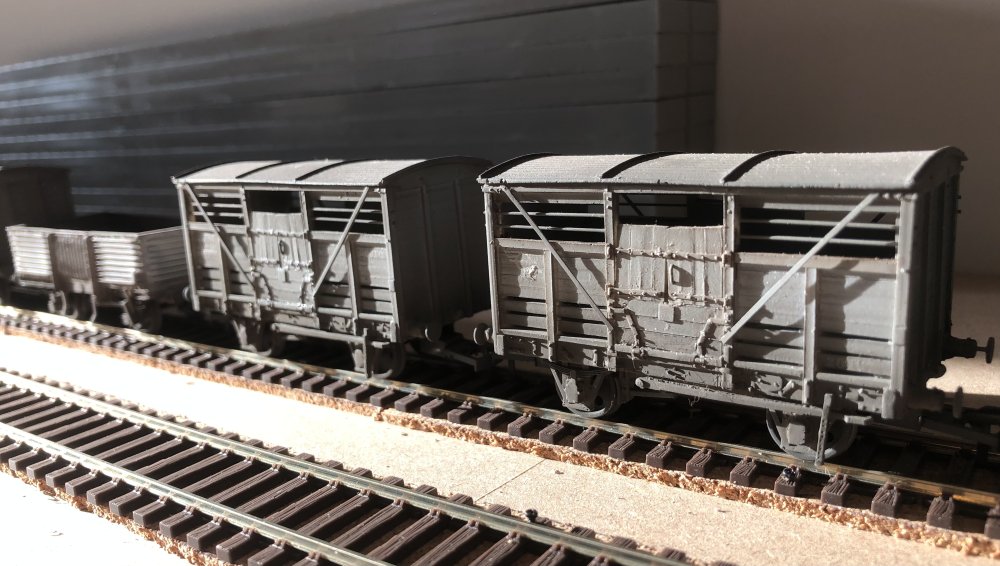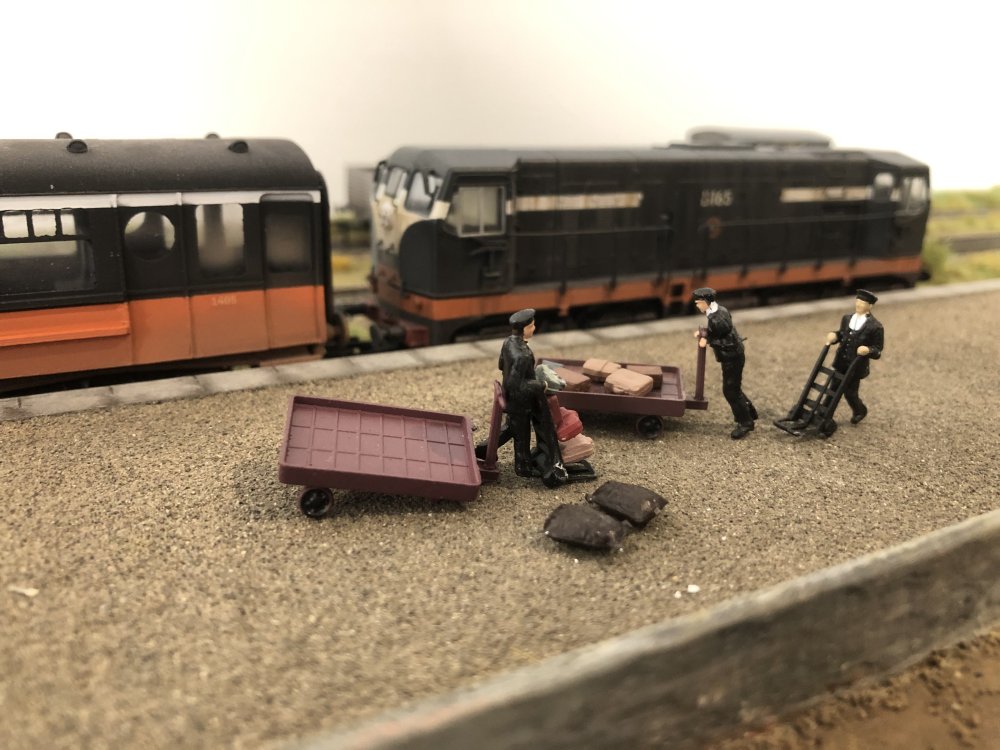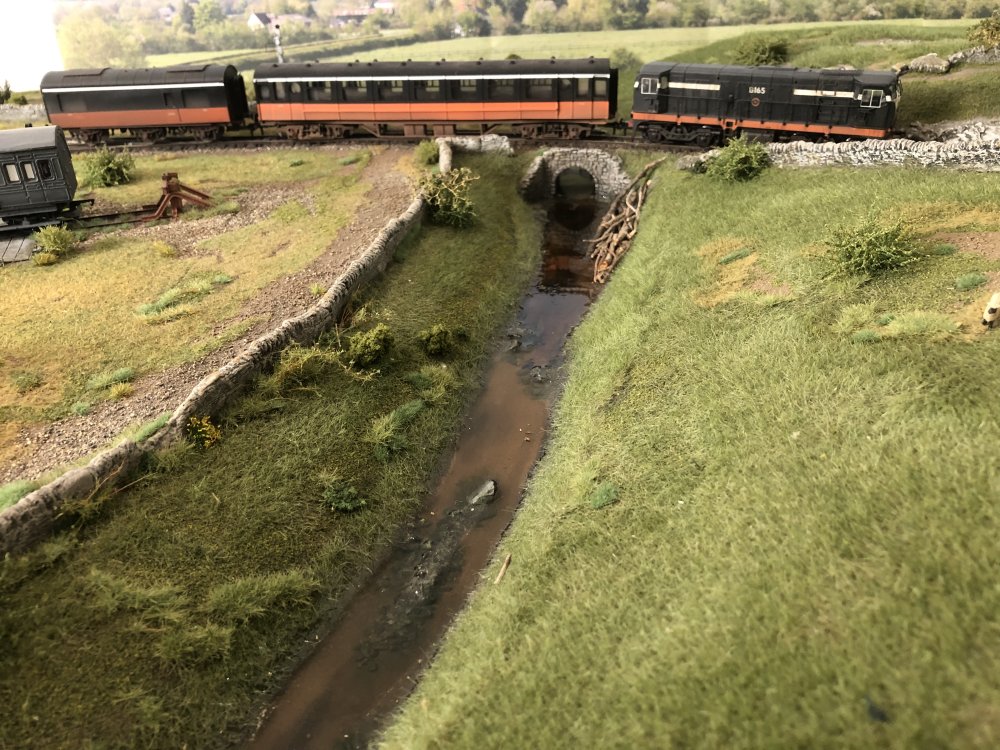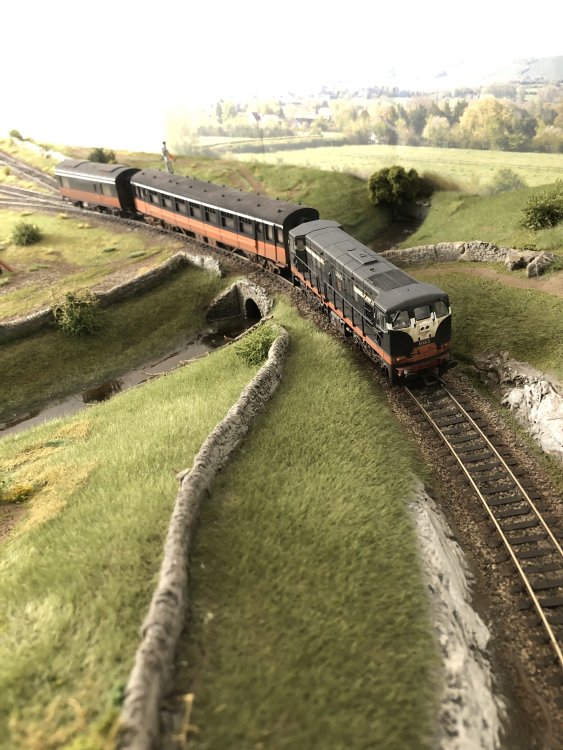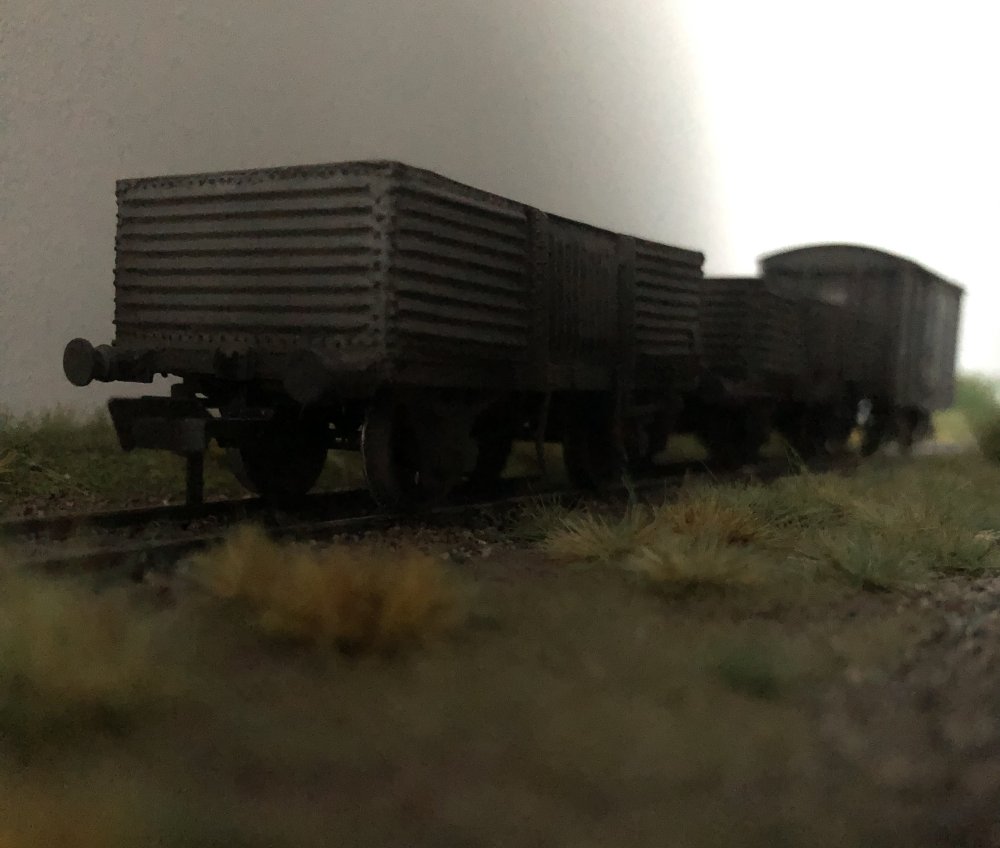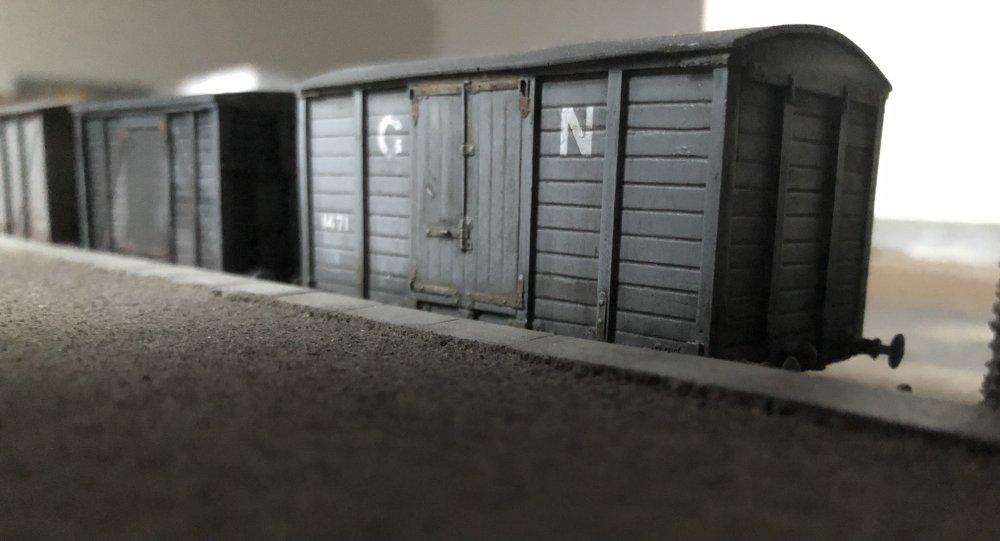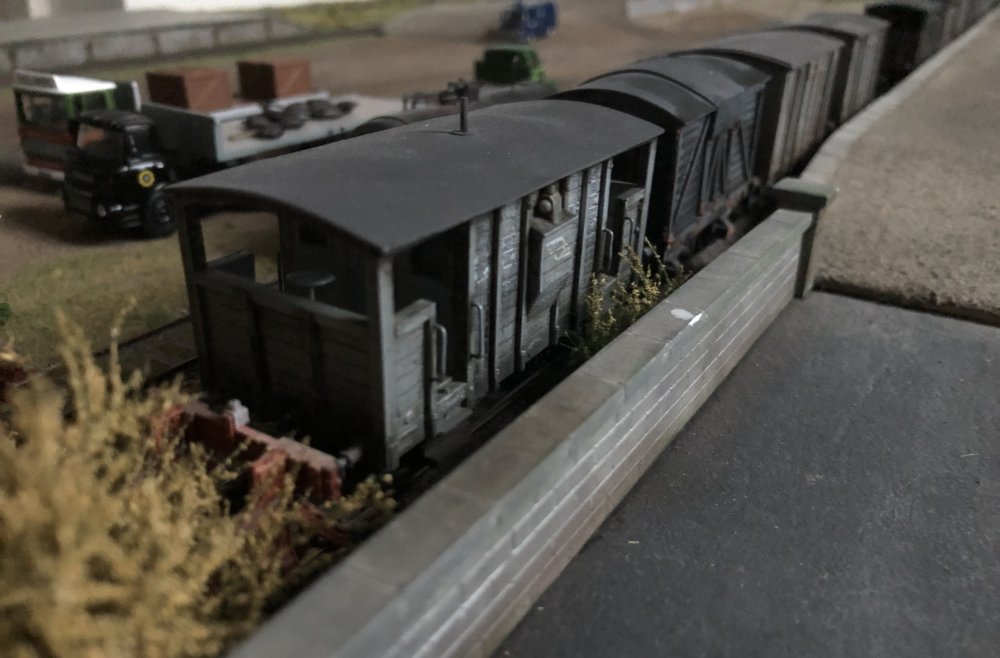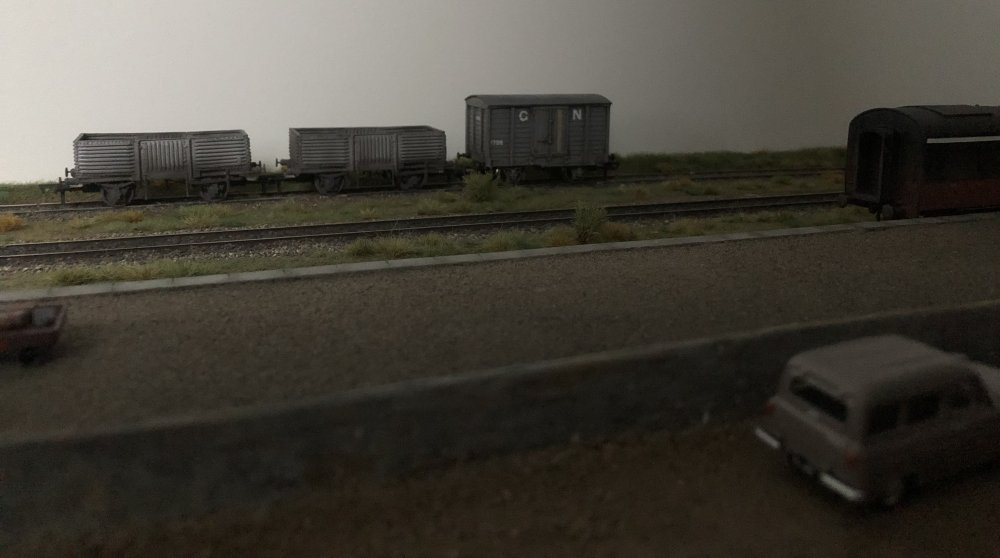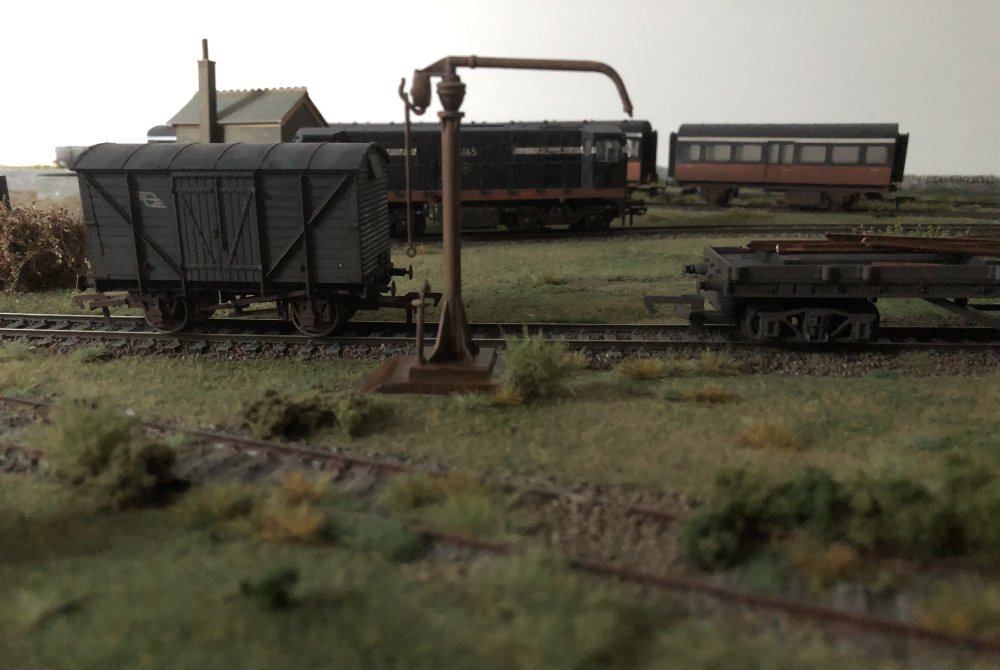-
Posts
15,817 -
Joined
-
Last visited
-
Days Won
393
Content Type
Profiles
Forums
Events
Gallery
Blogs
Store
Community Map
Everything posted by jhb171achill
-
Not sure I've seen an "M" suffix on a plate either. I would say that in GSR days there should have been a few, but there was a pogrom of MGWR wagons in the fifties, so probably few - if any at all - CIE, and as you suggest any few GSR ones long gone. 10 tons would presumably have been a goods van.
-
And I'm just noticing - I threw a few sleeper off-cuts into the open wagon amongst the turf, but they don't blend in as well as you'd think! Probably about six in there......... (Must do better!)
-
Eamonn Ryan, if you’re listening, turn your head away. Because they’re still digging turf down in West Kerry, and will be until I pop my clogs. Here, loads in a truck and an open wagon must come from somewhere, so there will be a turf bog as seen. Vertical marks where it has been cut were a fiddly thing to reproduce half-convincingly. Acrylic paints next….
-
Got that - just wondering what possibilities for N gauge 6-wheel coaches!
-
EXCELLENT kits! I've yet more on order......... I love those 6-wheel fish vans....... what's that 6w chassis like?
-
When starting scenery, in this case with DAS clay and a handful of stones out of the garden as rocks, I have found that it’s very easy to make even ground features very overscale. I have found that setting features in place first, then taking pictures of them in black and white against a backdrop of a wagon or locomotive, tends to show up very starkly whether they’re about right or not. Here, an area intended to be very rocky with gorse or brambles all round it. I removed some bigger ones, and pressed these ones down more into the DAS clay.
-
Following another visit by my Learned Friend, today was a momentous occasion as the first goods train rolled into Castletown West from the Dugort Harbour direction. The evening sunlight illustrates this, and the great detail on several Provincial Wagons products, plus a JM Design brake van, perfectly.
-
The Mallow goods is busy tonight…. IMG_4386.MOV
-
“Wheel’s off it. We’ll have to carry the rest to the van” “That oul trolley hasn’t even been oiled since the Tans were here…..” On a September afternoon in 1966, the afternoon train leaves Dugort Harbour…
-
I went through some material I have last night to see what was visible in photos of wagons. No photo I saw had a plate even remotely like that. With a number that high, it cannot be a locomotive obviously, nor a carriage; in any event, MGWR carriages had a very distinctive type of plate, totally different from those in every way - shape, print font, the lot - and ALL carriages ones had "MGWR" on them. Thus, if it is genuine it can only be off a wagon. Wagons seem not to have had cast plates on the chassis at all - instead they had only the painted numbers on the sides. I have seen no photo which shows any sort of wagon plate. As I suggested earlier the only likelihood is that it is off some very non-standard vehicle. Such things did exist - at one stage I had what I suspect was a one-off GNR(I) plate for a rebuild of a wagon in 1940. It was made of lead rather than cast iron too, but had a proven provenance as genuine - jhb171Senior wrenched it off a scrapper in Dundalk in the 1960s. Indeed, yes - the actual number of this thing is indeed plausible - the Midland had vast numbers of cattle trucks which would push up numbers. When the GSR and later CIE cast plates with the "M" suffix, they were of their standard "D" shaped design, with "GSR" or "CIE" on them rather than MGWR (with or without the "I"!)......
-
It does LOOK genuine; if it's a dud it's a very good one. Yes, the Midland could have had numbers that high - but my concern is the "(I)" bit after "MGWR". The OFFICIAL name of the company was, note order of wording, the "Midland Great Western of Ireland Railway Company"; not the "Midland Great Western Railway of Ireland". Thus, strictly, if the "I" is to be included, one would be inclined to think it would translate into initials as "MGW(I)R". It was normal on MGWR carriage plates and other notices, trespass signs and the like to use simply "MGWR". I would prefer to see this thing in the flesh, as it were, in order to deremine its authenticity or lack thereof; as of now, the jury's out. It is possible it was off one of those imported Belgian wagons - like General Motors' 1976 livery for the 071s, which was arong in several ways from the actual CIE livery of the day, and the "flying snail" on the control desk of NIR's three 071s, it's possible that a "foreign" manufacturer got the details wrong - but that's on the assumption that it was they, rather than Broadstone, who cast these plates in the first instance.
-
Looks great! Very West-Corkish......... (or Waterford-Macmine-ish...)!
-
I was asked recently by an esteemed fellow member of here about what older passenger rolling stock might be suitable (possibly with a 3D print in mind) for layouts set in the post-1955 period up to the present, and where they might have operated, and in what circumstances. In the late 1940s CIÉ did a massive purge of older wooden stock, resulting in the elimination of most types beyond MGWR and GSWR standards. DSER stock, in particular, took a big hit - although the GSR had been drafting "foreign" stock into the DSER since the late 1920s - many MGWR six-wheelers on the Harcourt St line and GSWR main line types on the Amiens St - Wexford route. By 1955, the Park Royals were appearing, and within the next few years a large amount of varying types of laminates and their derivitaves, rebuilt early 1950s stock, and tin vans by the squillion - the latter replacing older six-wheel passenger brakes in many places. By 1960 and shortly afterwards, now many branch lines were closing. All of this meant a sharp decline in the late 1950s in older stock, but very many still remained in use up to and following the end of steam in 1963, into the "black'n'tan" era, and on into the mid-1970s; the VERY last wooden stock, including one or two non-corridor types, appear to have been withdrawn in 1974, by now confimed to Dublin peak hour traffic and the odd Cork-Youghal excursion. Six-wheelers which carried passengers were last seen in traffic in early 1963. However, several (I think six) six-wheeled full passenger brakes remained in traffic, the last couple ending up in black'n'tan (the only six-wheelers ever to do so) and surviving until 1968-70. All of these six or so were ex-GSWR types; one, as a convert to a brake first, is No. 69 preserved at Downpatrick. Hardly any two of those which were in use in the mid to late 1950s were precisely identical, especially the bogies. There were many, many one-off alterations and rebuilds over the years. Some of these vehicles were seventy years old and more, and still in daily use. Therefore, on the face of it, where does one start when deciding what is a good "typical" model of an all-too-necessary WOODEN coach for a 1950s or 60s layout? If we look at the different lines, and what was to be seen on them, we get a reasonable answer - MGWR six-wheeled 2nds and 3rds, and GSWR six-wheel passenger brakes; and in the world of bogies, GSWR side corridor composites and non-corridor 2nds and 3rds. By the late 1950s, a typical branch set on many lines was a GSWR bogie as above, with a tin van or two (one LV, one HV) topping and tailing it; thus, the guard could switch ends at the terminus. The north & south Wexford branches, Kenmare, Valentia Harbour, the West Cork branch lines, Loughrea, Ballina, Ballinrobe and Ballaghaderreen often had a make-up like this. Before the railcars the West Cork main line often had a similar consist, albeit with an old MGWR bogie apparently resident for some time at Albert Quay also; this set tended to be two bogies and a van. On the main line, GSWR bogies, albeit corridor ones, were still commonplace amongst main line and secondary trains, in amongst Bredins, Park Royals, laminates and even Cravens in the 1960s. The Cork line also had quite a few old GSWR bogie and six-wheel mail vans - the bogie ones lasting well into the 1960s. Few MGWR bogies seem to have made it into the diesel / black'n'tan era; there were a few, but GSWR stock ruled the roost in this category. On the other hand, MGWR types dominated in later days (up to 1963) amongst the passenger-carrying six-wheelers. These tended to run with ex-GSWR passenger brakes. Thus, if typical wooden stock is sought after by modellers, inasmuch as anything could be termed "typical"; we must look at three types: Up to 1963: 6-wheel MGWR 2nd & 3rd, 6-wheel GSWR passenger brake and GSWR bogie composite; all green. 1963-74: One of two GSWR 6-wheel passenger brakes, GSWR bogie composite, both black'n'tan. AS suggested, this is neither definitive nor absolute; there were a small few other types, but most wooden-bodied survivors tended to be of these types.
-
- 8
-

-

-
Brookhall Mill - A GNR(I) Micro Layout
jhb171achill replied to Patrick Davey's topic in Irish Model Layouts
I thought Henry Casserley took that one? -
An excellent piece of work, indeed. Joe would be one of a small band of people who would be absolute authorities on latter-day UTA and NIR steam, a much-neglected topic in our railway history.
-
Ah! OK - I had forgotten............... so circa 2012 maybe.
-
That 90 is a beauty. Mark tells me he can do it in either 00 or 0 scale. Tell me more about the MGWR coaches you have in mind! A GSWR side corridor bogie composite would also be a good addition to a 1950s / 60s layout. As six-wheeler numbers reduced after a pogrom of older types in 1949 (including most DSER ones), these bogies began to appear on branch lines and secondary lines, even in deep MGWR territory. They were commonplace, if not often the norm in branch sets at Ballinrobe, Ballaghaderreen, Ballina, Loughrea, Kenmare, Valentia Harbour, everywhere in Wisht Caark that still had a passenger service, Mallow-Waterford, Waterford-Rosslare and Waterford-Macmine.
-
Very realistic Just a livery question; when did IE start painting bogies black (with little blue, green or yellow bits)? Maybe ten years ago? Anyone? And related, on the subject of “modern image” - when did they start painting the tops of Bell containers white? They were dark blue at first…. Just curious.
-
Pure accident, David; the dusk light may claim the credit. I had got some bits for the scenery and it just happened to be past daylight when I left them up to the attic, so I just took those pics there and then to see what they would look like!
-
Hi Johnny Thats great news - 4 x 8 will give you an excellent start. Forgot to add - one of our esteemed members here does a kit for a GSWR signal cabin, and there’s also a model of Carlow station (GSWR) available. Someone here will provide links perhaps - must try to look it up.
-
Yes - educational indeed! One of its many "wow factor" qualities.
-
Looks just like a Harold Fayle photo found in the depths of the IRRS' catacombs!
-
Wow! Yet another masterpiece! The scenery, the rolling stock, the setting, the concept; absolutely perfect stuff.
-
Hypothetically they could, yes; albeit with some adjustment, perhaps, to various connections. The De Deitrichs are actually an adaptation of a design originally intended for electric haulage. However, as others suggest, I believe the future of railways here is hybrids at least, or more likely in the very long term, once the technology is suitable, battery-electric. Dr. Drumm was WAY ahead of his time. Distances in Ireland are short by international standards. Freight traffic is small, and since these trains operate in almost permanently fixed formations, battery-electric freight multiple units would seem to be the logical way forward - and that's if there will be any freight at all in the future. Despite all the fine talk, the NTA's attitude to rail freight seems to be a carbon copy of the UTA in the 1960s. NTA, UTA, same. Thus, expect to see the Irish Rail network in years to become as NIR is now, has been, and will be for evermore. Amen. Railcar heaven; a 5 fut 3 Luas. Maintenance by increasingly sophisticated yellow things, rather than loco-hauled maintenance trains. Therefore, I agree with the post above that the 071s and 201s will carry on, probably until the last of them falls to bits or they can't get spare parts. I doubt there will be a new fleet of locos of any hue, to be honest. Not complaining or praising such an idea; just stating what appears to me to be the obvious, whether any of us like it or not......... an evolving modern railway is better than none at all.
-
All is quiet on a September evening at dusk at Dugort Harbour in 1965. The sky is about to empty. Nobody about until the morning, but our gricer photographer has free reign - the gates lie open all the time, as they have done for years. The night watchman is at home listening to the wireless, the kettle simmering on the range. Tomorrow, B165 will assemble a short goods train and head up to town.
.png.c363cdf5c3fb7955cd92a55eb6dbbae0.png)

